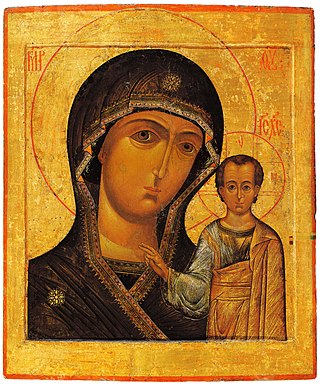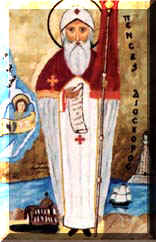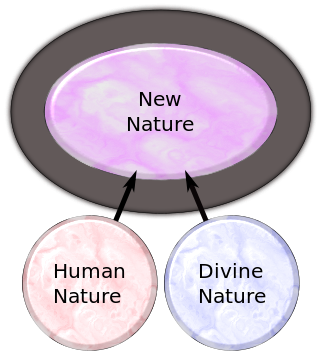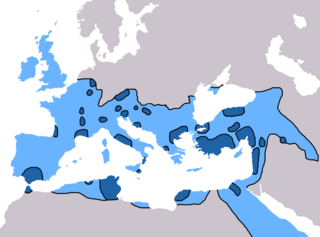
The Council of Chalcedon was the fourth ecumenical council of the Christian Church. It was convoked by the Roman emperor Marcian. The council convened in the city of Chalcedon, Bithynia from 8 October to 1 November 451 AD. The council was attended by over 520 bishops or their representatives, making it the largest and best-documented of the first seven ecumenical councils. The principal purpose of the council was to re-assert the teachings of the ecumenical Council of Ephesus against the heresies of Eutyches and Nestorius. Such heresies attempted to dismantle and separate Christ's divine nature from his humanity (Nestorianism) and further, to limit Christ as solely divine in nature (Monophysitism).
Nestorianism is a term used in Christian theology and Church history to refer to several mutually related but doctrinarily distinct sets of teachings. The first meaning of the term is related to the original teachings of Christian theologian Nestorius, who promoted specific doctrines in the fields of Christology and Mariology. The second meaning of the term is much wider, and relates to a set of later theological teachings, that were traditionally labeled as Nestorian, but differ from the teachings of Nestorius in origin, scope and terminology. The Oxford English Dictionary defines Nestorianism as "The doctrine of Nestorius, patriarch of Constantinople, by which Christ is asserted to have had distinct human and divine persons."

Theotokos is a title of Mary, mother of Jesus, used especially in Eastern Christianity. The usual Latin translations are Dei Genitrix or Deipara. Familiar English translations are "Mother of God" or "God-bearer" – but these both have different literal equivalents in Greek, Μήτηρ Θεοῦ and Θεοφόρος.

Eastern Christianity comprises Christian traditions and church families that originally developed during classical and late antiquity in Western Asia, Asia Minor, Eastern Europe, Southeastern Europe,the Caucasus, Northeast Africa, the Fertile Crescent and the Malabar coast of South Asia, and ephemerally parts of Persia, Central Asia and the Far East. The term does not describe a single communion or religious denomination.

The Council of Ephesus was a council of Christian bishops convened in Ephesus in AD 431 by the Roman Emperor Theodosius II. This third ecumenical council, an effort to attain consensus in the church through an assembly representing all of Christendom, confirmed the original Nicene Creed, and condemned the teachings of Nestorius, Patriarch of Constantinople, who held that the Virgin Mary may be called the Christotokos, "Christ-bearer" but not the Theotokos, "God-bearer". It met in June and July 431 at the Church of Mary in Ephesus in Anatolia.
Monophysitism or monophysism is a Christological term derived from the Greek μόνος and φύσις. It is defined as "a doctrine that in the person of the incarnated Word there was only one nature—the divine".
Chalcedonian Christianity is a term referring to the branches of Christianity that accept and uphold theological resolutions of the Council of Chalcedon, the Fourth Ecumenical Council, held in 451. Chalcedonian Christianity accepts the Christological Definition of Chalcedon, a Christian doctrine concerning the union of two natures in one hypostasis of Jesus Christ, who is thus acknowledged as a single person (prosopon). Chalcedonian Christianity also accepts the Chalcedonian confirmation of the Niceno-Constantinopolitan Creed, thus acknowledging the commitment of Chalcedonism to Nicene Christianity.

Nestorius was the Archbishop of Constantinople from 10 April 428 to August 431. A Christian theologian from the Catechetical School of Antioch, several of his teachings in the fields of Christology and Mariology were seen as controversial and caused major disputes. He was condemned and deposed from his see by the Council of Ephesus, the third Ecumenical Council, in 431.
Eutyches or Eutyches of Constantinople was a presbyter and archimandrite at Constantinople. He first came to notice in 431 at the First Council of Ephesus, for his vehement opposition to the teachings of Nestorius. At the 448 Synod of Constantinople and the 451 Council of Chalcedon, Eutyches was condemned for having adopted an equally extreme, although opposite view. He himself, however, would reject this interpretation of his thought.

Dioscorus I, also known as Dioscorus the Great, was the pope of Alexandria and patriarch of the See of St. Mark who was deposed by the Council of Chalcedon in 451. He was recognized as patriarch by the Coptic Church until his death. He died in Gangra, Paphlagonia, in September 454. He is venerated as a saint by the Coptic and other Oriental Orthodox Churches.

The Catechetical School of Antioch was one of the two major centers of the study of biblical exegesis and theology during Late Antiquity; the other was the Catechetical School of Alexandria. This group was known by this name because the advocates of this tradition were based in the city of Antioch, one of the major cities of the ancient Roman Empire.

The School of Nisibis was an educational establishment in Nisibis. It was an important spiritual centre of the early Church of the East, and like the Academy of Gondishapur, it is sometimes referred to as the world's first university. The school had three primary departments teaching: theology, philosophy and medicine. Its most famous teacher was Narsai, formerly head of the School of Edessa.

Eutychianism, also known as Real Monophysitism, refers to a set of Christian theological doctrines derived from the ideas of Eutyches of Constantinople. Eutychianism is a monophysite understanding of how the human and divine relate within the person of Jesus Christ, with Christ being in one nature and of two, with the humanity of Christ subsumed by the divinity.
The Second Council of Ephesus was a Christological church synod in 449 AD convened by Emperor Theodosius II under the presidency of Pope Dioscorus I of Alexandria. It was intended to be an ecumenical council, and it is accepted as such by the miaphysite churches but was rejected by the Chalcedonian dyophysites. It was explicitly repudiated by the next council, the Council of Chalcedon of 451, recognised as the fourth ecumenical council by Chalcedonian Christians, and it was named the Latrocinium or "Robber Council" by Pope Leo I; the Chalcedonian churches, particularly the Roman Catholic and Eastern Orthodox communions, continue to accept this designation, while the Oriental Orthodox repudiate it.

Coptic history is the part of the history of Egypt that begins with the introduction of Christianity in Egypt in the 1st century AD during the Roman period, and covers the history of the Copts to the present day. Many of the historic items related to Coptic Christianity are on display in many museums around the world and a large number is in the Coptic Museum in Coptic Cairo.

In the history of Christianity, the first seven ecumenical councils include the following: the First Council of Nicaea in 325, the First Council of Constantinople in 381, the Council of Ephesus in 431, the Council of Chalcedon in 451, the Second Council of Constantinople in 553, the Third Council of Constantinople from 680–681 and finally, the Second Council of Nicaea in 787. All of the seven councils were convened in western Anatolia.

The Oriental Orthodox Churches are Eastern Christian churches adhering to Miaphysite Christology, with approximately 60 million members worldwide. The Oriental Orthodox Churches are part of the Nicene Christian tradition, and represent one of its oldest branches.

In the 5th century in Christianity, there were many developments which led to further fracturing of the State church of the Roman Empire. Emperor Theodosius II called two synods in Ephesus, one in 431 and one in 449, that addressed the teachings of Patriarch of Constantinople Nestorius and similar teachings. Nestorius had taught that Christ's divine and human nature were distinct persons, and hence Mary was the mother of Christ but not the mother of God. The Council rejected Nestorius' view causing many churches, centered on the School of Edessa, to a Nestorian break with the imperial church. Persecuted within the Roman Empire, many Nestorians fled to Persia and joined the Sassanid Church thereby making it a center of Nestorianism. By the end of the 5th century, the global Christian population was estimated at 10-11 million. In 451 the Council of Chalcedon was held to clarify the issue further. The council ultimately stated that Christ's divine and human nature were separate but both part of a single entity, a viewpoint rejected by many churches who called themselves miaphysites. The resulting schism created a communion of churches, including the Armenian, Syrian, and Egyptian churches, that is today known as Oriental Orthodoxy. In spite of these schisms, however, the imperial church still came to represent the majority of Christians within the Roman Empire.

Christianity in late antiquity traces Christianity during the Christian Roman Empire — the period from the rise of Christianity under Emperor Constantine, until the fall of the Western Roman Empire. The end-date of this period varies because the transition to the sub-Roman period occurred gradually and at different times in different areas. One may generally date late ancient Christianity as lasting to the late 6th century and the re-conquests under Justinian of the Byzantine Empire, though a more traditional end-date is 476, the year in which Odoacer deposed Romulus Augustus, traditionally considered the last western emperor.

The Church of the East or the East Syriac Church, also called the Church of Seleucia-Ctesiphon, the Persian Church, the Assyrian Church, the Babylonian Church or the Nestorian Church, was an Eastern Christian church of the East Syriac Rite, based in Mesopotamia. It was one of three major branches of Eastern Christianity that arose from the Christological controversies of the 5th and 6th centuries, alongside the Oriental Orthodox Churches and the Chalcedonian Church. During the early modern period, a series of schisms gave rise to rival patriarchates, sometimes two, sometimes three. Since the latter half of the 20th century, three churches in Iraq claim the heritage of the Church of the East. Meanwhile, the East Syriac churches in India claim the heritage of the Church of the East in India.












